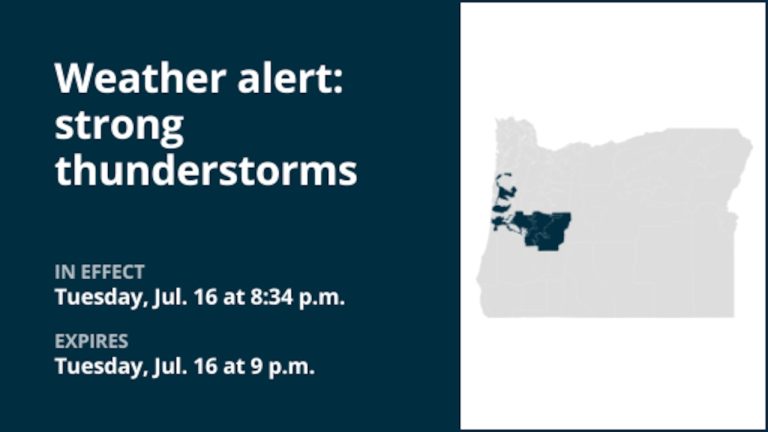The National Weather Service issued an updated report Tuesday at 8:34 p.m. for the Central Oregon Coast Range Lowlands, Central Oregon Coast Ranges, Lane County Lowlands, Lane County Cascade Foothills and Lane County Cascades areas until the evening There were severe thunderstorms at 9 o'clock.
The storm could bring wind gusts up to 40 mph and marble-sized hail (0.5 inches).
“At 8:33 p.m., Doppler radar tracked a severe thunderstorm near Cottage Grove, 17 miles southeast of Eugene, moving northwest at 35 mph,” the weather service said. “Strong winds were possible. Hail may cause minor damage to vegetation by blowing tree limbs down and around unsafe objects.”
Locations affected by the alert include Eugene, Springfield, Cottage Grove, Creswell, Veneta, Lowell, Santa Clara, North Springfield, Eugene Airport, River Road, Coburg, Cottage Grove Lake, Dorena Reservoir , Lorane, Walker, Fern Ridge Reservoir, Vaughn, Jasper, Pleasant Hill and Notty. This includes the following highways: Interstate 5 between mile markers 168 and 203. 0 between State Routes 126 and 7 from Eugene to McKenzie Bridge.
“If outdoors, consider seeking shelter inside a building,” the weather service said.
Be prepared for coming lightning: Expert safety advice
The United States experiences approximately 25 million lightning strikes each year, with most of these discharges occurring during the summer. Sadly, lightning kills about 20 people every year, according to weather department reports. The risk of lightning-related events increases as a thunderstorm approaches, peaking when a thunderstorm is directly overhead. However, as the storm moved away, it gradually receded.
To ensure your safety during a thunderstorm, consider the following tips:
Lightning Safety Plan:
- When venturing outdoors, having a lightning protection plan is crucial.
- Stay alert by monitoring the sky for ominous signs and listening for thunder. If you hear thunder, it's a sure sign that lightning is nearby.
- Find safe shelter, preferably indoors.
Indoor safety measures:
- Once you find shelter indoors, do not use corded phones, appliances, or plumbing fixtures, and stay away from doors or windows.
- These precautions help reduce the risk of power surges because lightning can travel along conductive paths.
Wait until everything clears up:
- After the last lightning strike or strike, wait at least 30 minutes before resuming outdoor activities.
- Even if a storm appears to have passed, lightning can strike, so be careful.
When indoor shelter is not available:
If you find yourself outdoors during a thunderstorm and unable to access an indoor shelter, take the following steps to maximize your safety:
- Avoid open fields, mountaintops, or ridges, which put you at greater risk of lightning strikes.
- Avoid tall, isolated trees and other protruding objects. In forested areas, stay closer to lower trees.
- If you are with a group of people, make sure people are spread out to prevent lightning currents from spreading from person to person.
- Camping in the open during thunderstorms is strongly discouraged. If you have no other options, camp in a valley, canyon, or other low-lying area. Keep in mind that tents do not provide lightning protection.
- Keep away from water, wet objects or metal objects. Although water and metals do not attract lightning, they conduct electricity effectively and can pose significant risks.
In summary, preparation and vigilance are your best allies when faced with lightning threats. By following these guidelines, you can significantly reduce the likelihood of a lightning-related incident and prioritize your safety.
Driving on Rainy Roads: Safety Tips for Wet Weather
When heavy rain falls, the risk of flooding and road hazards increases. Here are the weather service's guidelines for staying safe during a downpour:
Watch out for fast water flow:
Avoid parking or walking near culverts or drains, as fast-moving water during heavy rain may wash you away.
Maintain a safe driving distance:
Use the two-second rule to maintain a safe distance from the vehicle in front of you, and allow an extra two seconds in heavy rain.
Slow down and be cautious:
On wet roads, slowing down is crucial. Gradually ease off the accelerator and avoid sudden braking to prevent skidding.
Choose your lane wisely:
Stick to the middle lane on multi-lane roads to minimize the risk of hydroplaning, as water tends to pool in the outside lanes.
Visibility is important:
Turn on your headlights and be careful of other vehicles behind you and in your blind spots, as they will be difficult to see through rain-spattered windows.
Be aware of slippery roads:
Be extra careful in the first half hour after it rains. Dirt and oil on the road mix with water, making the road slippery.
Keep a safe distance from large vehicles:
Don't get too close to large trucks or buses. Splash from large tires can reduce your visibility. Also be careful when passing them; if you must pass, do so quickly and safely.
Pay attention to your windshield wipers:
Overloading the wiper blades can affect visibility. If heavy rain severely limits your visibility, pull over and wait for conditions to improve. Seek shelter in a rest area or protected location.
When on-street parking is your only option, move your vehicle as far away from the road as possible, preferably beyond a guardrail. Keep your headlights on and activate your emergency flashers to alert other drivers of your location.
By taking these safety measures, you can significantly reduce your risk and ensure your health when the rain pours. Stay informed about weather conditions and follow local government advice to ensure your journey is safe and worry-free.
Advanced Local Weather Alerts, a service from United Robots, uses machine learning to compile the latest data from the National Weather Service.
